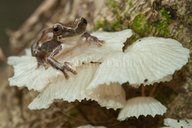|
Description
Males 18-21 mm,
females 23 mm. The dorsum is
orange-brown with a large dark
brown spot between the eyes and
another on the fore part of the back.
The snout is truncated. There is a
white horizontal bar below the eye.
The iris is orange brown. During the
day individuals may be whitish. Distribution and Habitat
Country distribution from AmphibiaWeb's database: Brazil, Colombia, Ecuador, French Guiana, Peru, Suriname
This species has
been recorded near some large ponds
beside the streams Acará and Ipiranga.Life History, Abundance, Activity, and Special Behaviors
The species is arboreal and nocturnal. Reproductive activities are observed throughout the six months of rainy season. Oviposition is closely associated with rainfall. Males were found calling from shrubs in and near ponds in March. Egg clutches are deposited on the upper surfaces of leaves of shrubs, and tadpoles fall into the water after hatching.
Notes on oviposition: Calling males hold females in an axillary embrace. Females then goes to leaves overhanging the water after amplexus. After arriving at the tip of the leaf, male-carrying females hold the edge of the leaf with their hindlegs, and remain still in an upward position for 18-125 seconds before egg deposition. Oviposition is characterized by periods of rest and activity, lasting around 14.2 s and 7 s, respectively. Activities begin with the females lifting their heads and taking on a position with a slightly arched back. The males then inseminate the eggs. Activities last approximately seven seconds and repeat every fourteen seconds. After insemination, the male rests his knee against the female body until the next bout begins. Zero to 14 eggs are laid in each bout. After each egg-laying bout, females use their hind legs to spread out the eggs into a single layer. The female oviposition maneuver continues up to about 9 bouts after the last egg has been laid; egg spreading continues up to forty minutes after the male's departure. This is perhaps to show the lateral bright markings and egg-shaped spots on the outer flanks of the female's thigh, and make the eggs appear to be lateral surfaces of the female body. All oviposition sites are above water, but the majority occur on the upper side of green leaves. Eggs are bright yellow. Eggs were usually eaten by carabid beetles and conocephalid grasshoppers. Five to seven days after oviposition, the tadpoles drop into the water and approximately 49% of the deposited eggs generally survived. Under artificially covered clutches, 88% survived. (Hödl 1991).
Comments
Similar species: Hyla minuta can be
easily distinguished by its yellow color
and lack of a white horizontal bar
below the eye.
For additional information on arboreal oviposition of Dendrosophus brevifrons, click the "view video" button above.
Click here to download Hödl's (1991) paper describing the film.
References
Hödl, W. (1991). ''Arboreal oviposition in the neotropical treefrogs Hyla brevifrons and Hyla sarayacuensis (Anura: Hylidae).'' Wiss. Film (Wien), 42, 53-62.
Originally submitted by: Albertina P. Lima, William E. Magnusson, Marcelo Menin, Luciana K. Erdtmann, Domingos J. Rodrigues, Claudia Keller, Walter Hödl (first posted 2007-11-21)
Edited by: Keith Lui, Christine Lu (2010-10-19)Species Account Citation: AmphibiaWeb 2010 Dendropsophus brevifrons <https://amphibiaweb.org/species/744> University of California, Berkeley, CA, USA. Accessed May 29, 2025.
Feedback or comments about this page.
Citation: AmphibiaWeb. 2025. <https://amphibiaweb.org> University of California, Berkeley, CA, USA. Accessed 29 May 2025.
AmphibiaWeb's policy on data use.
|
